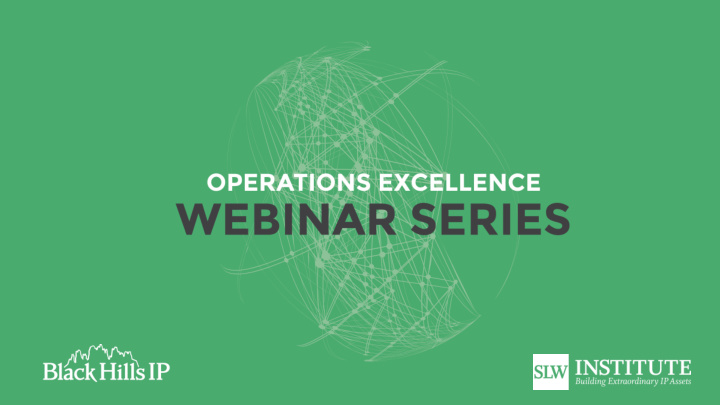



Managing Notices of Allowance, Issue Fee Payment and Continuation Practice
How to Manage Final Office Actions and Responses and RCE Practice • Presenters: • Ann McCrackin, President, Black Hills IP, LLC • Peter Rebuffoni, Manager of Legal Operations, Schwegman Lundberg & Woessner, P.A. • Joni C. Simaytis, Business Process Supervisor, Intellectual Property Department, Caterpillar Inc.
Where does a USPTO Notice of Allowance occur in the prosecution process? • A typical patent prosecution cycle includes the following basic steps: • Application is filed • A restriction requirement may be issued • A non-final and/or final rejection is issued • Responses to the non-final and/or final rejections are filed • Eventually, the application is either allowed, or the application is continued or abandoned
What are requirements when a USPTO Notice of Allowance (NOA) is received? • Once a NOA is received, the following items must be addressed: • Any missing oaths/declarations must be filed with USPTO before issue fee is paid • Any drawing corrections must be made before issue fee is paid • Any other formal requirements must be attended to (e.g., sequence listing) • Any prior art that was recently received, or previously received and just now identified, must be submitted • Any examiner interview summaries should be submitted • The issue fee must be paid within three (3) months of the mailing date of the NOA • Before the patent is issued, any divisional or continuation applications must be filed
What are optional actions that can be taken when a USPTO NOA is received? • A Rule 312 can be submitted typically to correct typographical errors • File continuations or divisionals • File an RCE to continue prosecution
What are typical docketing requirements for a USPTO NOA? • The core docketing requirement for a Notice of Allowance is a: • Three month deadline to pay issue fee. • Typical additional docket dates are: • One month docket date to review for any prior art newly received or not not cited • Docket one month for any formalities – drawings/oaths-declarations/sequences listings, etc. • Docketing for filing continuations/divisionals – covered later in more depth • Once issue fee is paid, docket a reminder for receipt of issued patent
Example Docketing Entries for NOA • Continuation/Divisional Decision - 2 months from Allowed Date • Issue Fee - 3 month Final Deadline from the Allowed Date • Formal Drawings Due - 3 month Final Deadline from the Allowed Date • Declaration Due - 3 month Final Deadline from the Allowed Date • Response to Examiner's Amendment - 3 month Final Deadline from the Allowed Date • Response to Examiner's Reason for Allowance - 3 month Final Deadline from the Allowed Date • Check Original Letters Patent Received – 6 months from the Allowed Date
What is typical Law Firm workflow docketing requirements for a USPTO NOA? • The typical docketing workflow for law firm when a Notice of Allowance is received: • Report of allowance to client/counsel • Administrative tasks put on staff docket • Substantive analysis on attorney docket • Report sent/assembled according to docketed process • Verify whether the list of inventors is accurate/correct in view of the allowed claim set • Obtain instructions to pay issue fee, or other • Pay the issue fee • File any required continuations or divisionals
What is typical corporate in-house IP department workflow docketing requirements for a USPTO Notice of Allowance? • The typical workflow docketing of a client/corporation for a Notice of Allowance is: • Receive report of NOA from law firm • Call/meeting with law firm to discuss options, or provide written instructions to law firm OR • Call/meeting with inside executives to discuss options • Determine budget constraints • After decision, update budget projections with any expenses authorized • Delegate/authorize and/or pay issue fee • In-house IP counsel may also evaluate the allowed claim set to verify it meets the strategy/goal of the application, covers a commercial product, etc. If not this can guide the in-house counsel when deciding whether to file a CON or even an RCE to continue prosecution and revise the claims.
Example Law Firm Checklist for Receipt of NOA • Verify whether the following are needed: • Corrected Application Papers or Formal Drawings • Summary of Examiner Interview / Response to an Examiner’s Amendment • Inventor’s Oath/Declaration and an updated ADS • Verify that the allowed claims and any Examiner’s amendment are correct • Verify whether the client/assignee/licensee has changed and whether the entity status is correct • Verify whether the Examiner has initialed and returned all SB/08 or 1449 forms • Verify whether any references/prior art in file still need to be cited in an IDS • If application has a foreign priority claim, have certified copies of the priority documents been supplied to the PTO • Are there related pending family members that are eligible for Patent Prosecution Highway (PPH) escalation in view of the allowed U.S. claims?
Example Law Firm Checklist for Payment of Issue Fee • Confirm and review any documents to be filed at or before payment of the issue fee, possibly including: • Examiner Interview Summary / Response to Examiner’s Amendment • Comments on Reasons for Allowance • Corrected Application Papers / Formal Drawings • Inventor’s Oath or Declaration and an updated ADS • Fee Address communication • Verify whether the client's Entity status (and applicable fees) as noted on the PTOL-85 are correct. • Confirm that all fees are being paid and deposit account authorization for any additional fees due is clearly noted • Confirm that any continuing application are being filed concurrently or are docketed for filing soon thereafter
Use of patent analytics to make prosecution decisions – ANY ANALYTICS HANDY HERE- FILE CONTINUATION IS BIG DECISION POINT
Recommend
More recommend